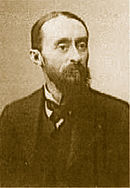Fernand Cormon
Fernand Cormon , actually Fernand-Anne Piestre Cormon, (* December 24, 1845 in Paris , † March 20, 1924 there ) was a French painter and director of the private painting school Atelier Cormon . In his day he was a well-known history painter in France, often painting religious subjects and later occasionally turning to portraiture . His painting style can be assigned to academic realism .
Live and act
Cormon began his painting studies in Brussels with Jean-François Portaels . In 1863 he returned to Paris, where he became a student of Alexandre Cabanel and Eugène Fromentin . Cormon never left the academic line in his works . He has exhibited at the Salon de Paris since 1868 and headed his private art school, the Atelier Cormon , in the 1880s , where he instructed his students in a painting that was recognized by the salon's jury. Among his students who did not achieve this goal because their painterly intentions deviated from the given style of the salon were, among others, Henri de Toulouse-Lautrec , Louis Anquetin , Eugène Boch , Émile Bernard and Vincent van Gogh .
In 1880, Cormon was accepted into the Legion of Honor . He made trips to Tunisia and Brittany . In 1898, Cormon became director of the École nationale supérieure des beaux-arts and a member of the Académie des Beaux-Arts . Henri Matisse , who had attended the École under Cormon's predecessor Gustave Moreau , had to leave it in 1899 because of disagreements with Cormon.
plant
Fernand Cormon specialized in biblical and prehistoric scenes in addition to the dark, highlighted subjects of modern life. In the painting Caïn (Cain), 384 × 700 cm in oil on canvas , which was the sensation of the salon in 1880 , he illustrated a verse from La legende des siècles (The Legend of the Centuries) by Victor Hugo : “ When Cain fled from Jehovah with his children wrapped in animal skins, with tangled hair, pale in the middle of the storms, / as it was evening, the dark man came in a great plain at the foot of a mountain [...] ”. For this work he worked every figure on a model and studied the results of archaeological research for their decoration . The painting was acquired by the French state and is now in the Musée d'Orsay in Paris .
Student (selection)
Web links
Individual evidence
- ↑ Lawrence Gowing: Matisse , Lichtenberg, Munich 1997, ISBN 3-785-28406-3 , p. 200
- ^ Caroline Mathieu: Musée d'Orsay . Édition de la Réunion des Musées Nationaux, Paris 1987; Quote from Victor Hugo, ibid. ISBN 2-7118-2124-2 , pp. 202-205;
- ↑ (1889-1892) [1]
| personal data | |
|---|---|
| SURNAME | Cormon, Fernand |
| ALTERNATIVE NAMES | Cormon, Fernand-Anne Piestre |
| BRIEF DESCRIPTION | French painter |
| DATE OF BIRTH | December 24, 1845 |
| PLACE OF BIRTH | Paris , France |
| DATE OF DEATH | March 20, 1924 |
| Place of death | Paris , France |


